Papers by José María Fernández-Palacios
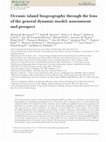
Biological Reviews, 2016
The general dynamic model of oceanic island biogeography (GDM) has added a new dimension to theor... more The general dynamic model of oceanic island biogeography (GDM) has added a new dimension to theoretical island biogeography in recognizing that geological processes are key drivers of the evolutionary processes of diversification and extinction within remote islands. It provides a dynamic and essentially non-equilibrium framework generating novel predictions for emergent diversity properties of oceanic islands and archipelagos. Its publication in 2008 coincided with, and spurred on, renewed attention to the dynamics of remote islands. We review progress, both in testing the GDM's predictions and in developing and enhancing ecological-evolutionary understanding of oceanic island systems through the lens of the GDM. In particular, we focus on four main themes: (i) macroecological tests using a space-for-time rationale; (ii) extensions of theory to islands following different patterns of ontogeny; (iii) the implications of GDM dynamics for lineage diversification and trait evolution; and (iv) the potential for downscaling GDM dynamics to local-scale ecological patterns and processes within islands. We also consider the implications of the GDM for understanding patterns of non-native species diversity. We demonstrate the vitality of the field of island biogeography by identifying a range of potentially productive lines for future research.
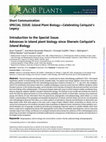
Sherwin Carlquist's seminal publications—in particular his classic Island Biology, published in 1... more Sherwin Carlquist's seminal publications—in particular his classic Island Biology, published in 1974—formulated hypotheses specific to island biology that remain valuable today. This special issue brings together some of the most interesting contributions presented at the First Island Biology Symposium hosted in Honolulu on 7–11 July 2014. We compiled a total of 18 contributions that present data from multiple archipelagos across the world and from different disciplines within the plant sciences. In this introductory paper, we first provide a short overview of Carlquist's life and work and then summarize the main findings of the collated papers. A first group of papers deals with issues to which Carlquist notably contributed: long-distance dispersal, adaptive radiation and plant reproductive biology. The findings of such studies demonstrate the extent to which the field has advanced thanks to (i) the increasing availability and richness of island data, covering many taxonomic groups and islands; (ii) new information from the geosciences, phylogenetics and palaeoecology, which allows us a more realistic understanding of the geological and biological development of islands and their biotas; and (iii) the new theoretical and methodological advances that allow us to assess patterns of abundance, diversity and distribution of island biota over large spatial scales. Most other papers in the issue cover a range of topics related to plant conservation on islands, such as causes and consequences of mutualistic disruptions (due to pollinator or disperser losses, introduction of alien predators, etc.). Island biologists are increasingly considering reintroducing ecologically important species to suitable habitats within their historic range and to neighbouring islands with depauperate communities of vertebrate seed dispersers, and an instructive example is given here. Finally, contributions on ecological networks demonstrate the usefulness of this methodological tool to advancing conservation management and better predicting the consequences of disturbances on species and interactions in the fragile insular ecosystems.
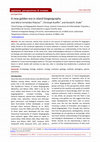
For two centuries, islands have served as rich sources of inspiration and data for biogeographers... more For two centuries, islands have served as rich sources of inspiration and data for biogeographers, thus gaining renown as ideal natural laboratories. Their research potential continues to expand today thanks to the combined application of recent advances in several scientific fields. First, increasingly detailed geological and palaeoecological data are extending our understanding of the history of development of island biotas. At the same time, rapid methodological advances in molecular evolutionary biology and systematics are revealing the pathways by which species colonized islands, evolved, and formed communities. Third, basic data on species distributions are being collected from increasing numbers of islands and taxa, distributed widely through electronic resources, and analyzed with powerful software to reveal macroecological patterns. The pace and quality of recent advances signal a promising future in which islands will continue to play key roles in revealing how biodiversity is produced and maintained.
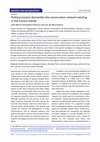
The outstanding nature of the Canary Islands has been recognized by European, national and region... more The outstanding nature of the Canary Islands has been recognized by European, national and regional administrations since the arrival of democracy in Spain. Forty-five per cent of its emerged territory has been declared as Natural Protected Areas, four Canarian National Parks were included within the Spanish network, more than 200 endemics were listed in the Spanish catalogue of endangered species, and 450 species were listed in the Canarian catalogue of protected species. However, in recent years, political decisions have started dismantling this splendid conservation network, which impedes construction of large infrastructure, golf courses and resorts, despite the advice of the scientific community. Canarian nature is now facing two threats: delisting and downgrading of numerous endangered species, and transfer of the management of Canarian National Parks to the regional administration.

The invasion of non-native plant species is one of the greatest threats to natural ecosystems, an... more The invasion of non-native plant species is one of the greatest threats to natural ecosystems, and oceanic islands are especially susceptible to this threat. Fire, as a disturbance factor, has been found to promote non-native species invasion and fire intensity is one of the variables determining the severity of invasions. This study was designed to determine the impact of non-native species in the Tenerife pine forest understory on the island of Tenerife, Canary Islands, Spain, and how they are affected by low and high intensity wildfire. We resampled in 2006 the plots set for a previous study in 1998 within the area affected by a wildfire in June 1995. Six control plots, nine low-severity burned plots and twelve high-severity burned plots were sampled three and eleven years after fire. Native species cover increased in high severely burned plots with respect to control plots. It also increased in low and high severely burned plots from 1998 to 2006. No differences were found for non-native cover and richness between fire intensities or in time. Results suggest that some of the native understory plant species are adapted to high intensity fire and respond by increasing their cover after fire to the detriment of non-native species. Forest management with prescribed fire may not increase nonnative species invasion as has occurred in other ecosystems.
Apis mellifera L. is a generalist pollinator present in most of the Canary Islands. When foraging... more Apis mellifera L. is a generalist pollinator present in most of the Canary Islands. When foraging, honeybees transfer pollen grains to honey, and presence and abundance of pollen from different species can be interpreted as a sign of local flora, and a cue to spread of aliens. The relative use of alien vs native species by honeybees could influence island pollination mutualisms and/or favour alien species. Analyzing pollen content data from honey samples an approach can be made to the relative foraging intensity on different plant communities and identify the importance of alien plant species in nearby areas.
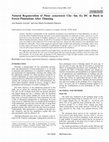
Thinning is indispensable for the sustainable development and naturalization of forest plantation... more Thinning is indispensable for the sustainable development and naturalization of forest plantations. In order to reveal the effect of different thinning intensities on the natural regeneration of a plantation of Pinus canariensis, we followed for two years the density of seedlings, saplings of 1 year, saplings of 1-2 years and saplings of > 2 years in plots at different thinning intensities (control, 20 and 50%). Our analysis revealed that seedling density and density of saplings > 2 years were higher in plots thinned by 50% of their total basal area, whereas the other categories were significantly more abundant in control plots. These results suggest an important impact of light in the germination of seedlings, while a more covered canopy will increase the probability of establishment of saplings 1 and 1-2 years old. However, for saplings > 2 years, the lack of space found in control plots largely determined their low abundance.

The concern that climate change may increase fire frequency and intensity has recently heightened... more The concern that climate change may increase fire frequency and intensity has recently heightened the interest in the effects of wildfires on ecosystem functioning. Although short-term fire effects on forest soils are well known, less information can be found on the long-term effects of wildfires on soil fertility. Our objective was to study the 17-year effect of wildfires on forest net mineralization rates and extractable inorganic nitrogen (N) and phosphorus (P) concentrations. We hypothesize that (1) burned forest stands should exhibit lower net mineralization rates than unburned ones; (2) these differences would be greatest during the growing season; (3) differences between soil variables might also be observed among plots from different years since the last fire; and (4) due to fireresistant geochemical processes controlling P availability, this nutrient should recover faster than N. We used a wildfire chronosequence of natural and unmanaged Pinus canariensis forests in La Palma Island (Canary Islands). Soil samples were collected during winter and spring at 22 burned and unburned plots. We found significantly higher values for net N mineralization and extractable N pools in unburned plots. These differences were higher for the winter sampling date than for the spring sampling date. Unlike extractable N and N mineralization rates, extractable P levels of burned plots exhibited a gradual recovery over time after an initial decrease. These results demonstrate that P. canariensis forest soils showed low resilience after wildfires, especially for N, and that this disturbance might induce long-term changes in ecosystem functioning.
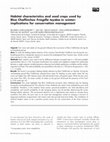
Capsule Tree cover and seeds on the ground influence the occurrence of Blue Chaffinches during th... more Capsule Tree cover and seeds on the ground influence the occurrence of Blue Chaffinches during the non-breeding period. Aims To study the feeding habitat selection of the common Tenerife Blue Chaffinch race during the nonbreeding period as a desperate measure to conserve the endangered Gran Canaria race, whose critical area was burnt in the summer of 2007. Methods Basic statistics were used to test for differences between occupied sites (n = 35) and available representative sites (n = 35). Univariate classification tree models were applied to explore the relationship between a single response variable (presence-absence) and multiple explanatory variables and the relative importance of these. Pine seed availability was quantified on the trees (n = 70) and on the ground (n = 140; 1 × 1 m plots). Results We found a non-random feeding habitat selection by Blue Chaffinches on Tenerife. During the non-breeding period Blue Chaffinches selected those areas for feeding on pine seeds where the tree cover was higher than 38% (mature areas with tall and thick trees with good crops). When the tree cover was lower than 38%, the mean number of seeds on the ground influenced the presence of this finch (> 0.05 seeds per m 2 ). Conclusions This study highlights that Blue Chaffinches primarily select sheltered sites for feeding during the non-breeding period. The selection of less sheltered sites seems to be mediated by pine seed availability. Therefore, in this endemic forest system, perceived predation risk, food abundance and availability, and overall availability of safe foraging options are all possibly determining the winter feeding habitat selection. We recommend selective cuts in high-density pine stands to recreate those conditions that allow the pine trees to set seed and management aimed at creating a structure of dispersed small-area compartments with mature trees that provide food and shelter. The installation of artificial feeders seems to be a post-fire priority action for the conservation of the Gran Canaria race. E. Garcia-del-Rey et al. © 2009 British Trust for Ornithology, Bird Study, 56, 168-176

Identifying ecological requirements, species diversity patterns and distribution ranges of habita... more Identifying ecological requirements, species diversity patterns and distribution ranges of habitats of interest is an important task when developing conservation and restoration programs. The Canarian juniper woodland formed by Juniperus turbinata ssp. canariensis is listed as a priority habitat by the European Union. Although very common in the past, this vegetation type has suffered immense destruction and degradation over the last five centuries on the Canary Islands, especially on the largest most populated island of Tenerife. We evaluated the geographical distribution range of the last remnants of Canarian juniper woodlands on Tenerife and analyzed their ecological status, floristic composition and plant species diversity. Despite the degradation of the original vegetation, we still observed outstanding species diversity. Endemic species richness and number of typical habitat species were best predicted by summer rainfall, which seems to be the limiting factor for this habitat in the lower drier regions. Human disturbance has had a negative effect on endemic species richness but a positive effect on the distribution of alien plants, highlighting the potential threat to this habitat. Ecological characterization and floristic composition were most influenced by climatic factors related to the dichotomy of a humid windward and a drier leeward slope of the island and by altitude. However, vegetation structure and human disturbance also determined species composition. Environmental requirements indicated a circuminsular potential distribution of this habitat. Given the exceptional plant diversity, the scarcity of dense stands and the low protection status, immediate protection of the remaining stands and future restoration programs should be the priority for conservation strategies of this endemic vegetation type.
analogous trends to those of aliens. This suggests climatic matching as a prerequisite for succes... more analogous trends to those of aliens. This suggests climatic matching as a prerequisite for successful invasion of this topographically complex island. Other road traits, such as edge width, slope steepness, soil cover, and road-edge disturbance intensity may play a complementary role, at a more local scale, to shape the distribution of alien plants on these island roads.
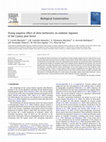
We studied the effects of herbivores on populations of four endemic legume species in pine forest... more We studied the effects of herbivores on populations of four endemic legume species in pine forests in Caldera de Taburiente National Park on La Palma, Canary Islands. Seeds of these species were sown in control and herbivore-exclusion plots. Over the subsequent 4-years period, we assessed the effects of herbivores by counting the number of individual plants that emerged and by following their growth. We assessed growth over time using three plant-size categories. For these four species, we conclude that the presence of herbivores, including barbary sheep (Ammotragus lervia), goat (Capra hircus) and European rabbit (Oryctolagus cuniculus), exerts a strong negative effect on plant establishment. We suggest that the paucity of understory plant species in the pine forests of the Canary Islands may be strongly correlated with the presence of introduced herbivores in this region. We propose urgent conservation measures, such as large fenced areas, control activities and the most effective measure, eradication.
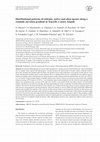
Invasion by alien plant species may be rapid and aggressive, causing erosion of local biodiversit... more Invasion by alien plant species may be rapid and aggressive, causing erosion of local biodiversity. This is particularly true for islands, where natural and anthropogenic corridors promote the rapid spread of invasive plants. Although evidence shows that corridors may facilitate plant invasions, the question of how their importance in the spread of alien species varies along environmental gradients deserves more attention. Here, we addressed this issue by examining diversity patterns (species richness of endemic, native and alien species) along and across roads, along an elevation gradient from sea-level up to 2050 m a.s.l. in Tenerife (Canary Islands, Spain), at multiple spatial scales. Species richness was assessed using a multi-scale sampling design consisting of 59 T-transects of 150 m × 2 m, along three major roads each placed over the whole elevation gradient. Each transect was composed of three sections of five plots each: Section 1 was located on the road edges, Section 2 at intermediate distance, and Section 3 far from the road edge, the latter representing the "native community" less affected by road-specific disturbance. The effect of elevation and distance from roadsides was evaluated for the three groups of species (endemic, native and alien species), using parametric and non-parametric regression analyses as well as additive diversity partitioning. Differences among roads explained the majority of the variation in alien species richness and composition. Patterns in alien species richness were also affected by elevation, with a decline in richness with increasing elevation and no alien species recorded at high elevations. Elevation was the most important factor determining patterns in endemic and native species. These findings confirm that climate filtering reflected in varying patterns along elevational gradients is an important determinant of the richness of alien species (which are not adapted to high elevations), while anthropogenic pressures may explain the richness of alien species at low elevation. Nomenclature: Izquierdo et al. (2014) Abbreviations: MIREN-Mountain Invasion Research Network; PERMANOVA-Permutational Analysis of Variance.
Aim Conifers comprise an ancient and diverse group of plants showing a wide distribution range. T... more Aim Conifers comprise an ancient and diverse group of plants showing a wide distribution range. To better understand the general patterns of species successfully established on islands, this review compiles information about the distribution, diversity, dispersal potential and conservation status of insular conifers, with special emphasis on those inhabiting remote oceanic islands.

Understanding speciation on oceanic islands is a major topic in current research on island biogeo... more Understanding speciation on oceanic islands is a major topic in current research on island biogeography. Within this context, it is not an easy task to diff erentiate between the infl uence of elevation as an indicator for habitat diversity and island age as an indicator for the time available for diversifi cation. One reason for this is that erosion processes reduce the elevation of islands over time. In addition, the geographic distance to source ecosystems might diff er among habitats, which could lead to habitat-specifi c reduction of species immigration, niche occupation and diversifi cation. We used the percentage of single island endemic species (pSIE) in fi ve diff erent zonal ecosystems (distributed in altitude) on the Canary Islands as an indicator for diversifi cation. We tested whether diversifi cation increases with altitude due to a greater ecological isolation of high elevation ecosystems on oceanic islands under the assumption of a low elevation source region on the mainland. In addition we tested whether the ' hump-shaped ' (unimodal) relationship between pSIE and island age as well as the linear relationship between species richness and pSIE is consistent across spatial scales. We also analyse a potential infl uence of island area and habitat area. We found that pSIE increases with elevation. Th e relations between species richness as well as age with pSIE are consistent across scales. We conclude that high elevation ecosystems are ecologically isolated. Surprisingly, the altitudinal belt with the strongest human infl uences has the highest values of pSIE. We successfully transfer the ' general dynamic theory of island biogeography ' to the ecosystem scale, which provides multiple opportunities for future studies. With this approach we fi nd that the eff ects of elevation on diversifi cation can be separated from those of island age.

The direct equivalence between ecology and thermodynamics has not been attained despite accepted ... more The direct equivalence between ecology and thermodynamics has not been attained despite accepted thermodynamic features of the ecosystem. This article explores the homeomorphism between ecology and statistical mechanics by analysis of ruderal vegetation. In conventional thermostatistical algorithm, the pro-kinetic effect of temperature on molecules was replaced by the anti-kinetic effect of species diversity on biological individuals. The existence of an ecological equivalent of the thermodynamic Boltzmann constant was empirically verified. From the relationship of this constant with biocenological variables, we derived a probable ecological equation of state under stationary and quasi-stationary conditions. This equation of state is homeomorphic with regard to the ideal gas state equation, and it is useful to infer the value of some biocenological parameters whose direct measurement is difficult, as biomass, energy and dispersal. According to these results, ecosystem assessment from conventional thermostatistics is plausible and empirically verifiable. This approach offers useful analytical tools for the conservation and restoration of ecosystems.
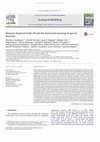
Production-diversity patterns lack a single explanation fully integrated in theoretical ecology. ... more Production-diversity patterns lack a single explanation fully integrated in theoretical ecology. An ecological state equation has recently been found for ruderal vegetation. We studied 1649 plots from twenty-nine ecological assemblages and analyzed the relationship between diversity, biomass and dispersal looking for a pattern across these ecosystems. We found that high biomass and low dispersal values were significantly associated with high diversity plots under stationary conditions, and vice versa, involving a biomass-dispersal trade-off that is coherent with well-established ecological principles. Therefore, energy per plot, estimated as one half of the product of mean individual biomass and mean square dispersal multiplied by the number of individuals per plot, only reaches its maximum at intermediate levels of diversity. This explains the well-known humped relationship between production and diversity. We also explore why the rest of the diversity-production patterns can be explained starting from disruptions of this basic pattern. Simultaneously, the product of diversity, biomass and square dispersal is statistically equal to the ecological equivalent of the Boltzmann's constant included in the ecological state equation that remains valid for all the assemblages explored due to scale variations in the value of the abovementioned constant. Biomass-dispersal trade-off resembles the principle of equipartition of energy from the kinetic theory of gases but in a characteristic way, because the alternative micro-associations of dispersal-biomass in function of species diversity are not randomly distributed as it happens with the combinations of molecular mass and velocity in a mixture of gases. Therefore, this distinctive ecological feature should be assumed as one of the main pro-functional gradients or thermodynamic constraints to avoid chaos and ecological degradation under stationary conditions. Hence, biomass-dispersal tradeoff explains production-diversity patterns and the ecological state equation in simultaneous agreement with conventional ecology and physics.
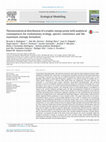
Conventional thermodynamics and statistical mechanics deal with the study of physical systems und... more Conventional thermodynamics and statistical mechanics deal with the study of physical systems under equilibrium conditions (EC). Internal EC at a temperature that differs from the environment temperature are sustained, in general, by some type of artificial boundaries imposed with research aims or with quotidian utility goals in many kind of domestic appliances; the typical example of academic lab is a closed system immersed in a thermal bath which keeps the temperature constant. However, the ecosystem is a far-from-EC open system. Therefore, conventional thermodynamics and statistical mechanics tend to be orthodoxly regarded as limited to explain the ecosystem functioning since, at the first glance; there seem to be several essential functional differences between it and the previouslymentioned kind of physical systems. This viewpoint averse to conventional physics is paradoxical in regard to the current ecological paradigm given the fully thermodynamic foundation of ecosystem ecology. However, additional evidence in favor of the usefulness of conventional physics to describe the ecosystem functioning have recently been published, pointing out to the possibility that the analytical approach to ecology based on our undergraduate knowledge of physics, unfortunately, could have been hastily neglected before producing its most valuable results. This paper, fully based on the abovementioned evidence, performs an unavoidable additional step in order to complete such a proposal by showing that the Boltzmann distribution of molecular energy values can be simply and successfully adapted to model the distribution of values of a proxy for trophic energy across an increasing gradient of energy levels, in a very similar fashion to that of a standard trophic pyramid. Starting from this result and by using a balanced combination between plausible theoretical considerations and abundant empirical data, we analyze why this approach is in agreement with well-known ecological principles, at the same time that we explore the general empirical advantages and aftermaths derived from this suggestion. Finally, the article explores the usefulness of the thermo-statistical modeling of eco-kinetic energy per plot to understand those essential physical factors that: promote biological evolution, facilitate species coexistence, can explain the holes in the fossil record, and enhance our current viewpoint about the ecological meaning of entropy. In summary, this article provides simply understandable additional information that indicates, despite its far-from-EC nature, any natural ecosystem is not far away from the most orthodox principles of conventional physics.
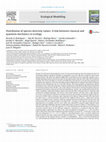
Despite the well-known thermodynamic traits of ecosystem functioning, their description by means ... more Despite the well-known thermodynamic traits of ecosystem functioning, their description by means of conventional physics should be regarded as incomplete, even if we take into account the most recent advancements in this field. The analytical difficulties in this field have been especially complex to get a reliable modeling of species diversity per plot (H p ) by endowing this indicator with a fully clear theoretical meaning. This article contributes to resolve such difficulties starting from (a) the previous proposal of an ecological state equation, and (b) the preceding empirical finding of an ecological equivalent of Planck's constant at the evolutionary scale. So, in the first instance, this article proposes an equation for density distributions of H p values (ED H ) based on a simple transformation of the Maxwell-Boltzmann distribution for molecular velocity values (M-BD v ). Our results indicate that the above-mentioned equation allows an appropriate fit between expected and observed distributions. Besides, the transformation from M-BD v to ED H establishes connections between species diversity and other indicators that are consistent with well-known ecological principles. This article, in the second instance, uses ED H s from a wide spectrum of surveys as an analytical framework to explore the nature and meaning of stationary trophic information waves (STIWs) whose stationary nature depends on the biomass-dispersal trade-off in function of H p values (B-D TO-H ) that characterizes the most of the explored surveys. B-D TO-H makes these surveys behave as ecological cavity resonators (ECR) by trapping functional oscillations that bounce back and forth between the two opposite edges of the ECR: from r-strategy (at low biomass and diversity, and high dispersal) to K-strategy, and vice versa. STIWs were obtained by using the spline-adjusted values from the arithmetical difference between standardized values of species richness (S) and evenness (J ) in function of H p values (i.e., a 2D scalar space H p , S-J ). Twice the distance on the abscissas (2 H p ) between successive extreme values on the ordinates (whatever a maximum or a minimum) along the abovementioned spline adjustment was taken as the value of ecological wavelength ( e ). e was assessed in order to obtain the value of the ecological equivalent of Planck's constant (h e ec ) at the intra-survey scale that was calculated as: h e ec = e × m e × I e ; where m e : individual biomass, and I e : an ad-hoc indicator of dispersal activity. Our main result is that the observed value of h e ec 's mantissa is statistically equivalent to the mantissa of the physical Planck's constant (h = 6.62606957E − 34 J s) in all of the discontinuous (i.e., with interspersed categories in which n = 0) statistical density distributions of H p values per survey. R.A. Rodríguez et al. / Ecological Modelling 313 (2015) 162-180 163 This means that h e ec = 6.62606957Eϕ J e nat/individual, where ϕ = −x i , . . ., −3, −2, −1, 0,+1, +2, +3, . . .,+x i depending on the type of taxocenosis explored. That is to say, h e ec indicates the minimum amount of energy exchange allowed between two individuals. The exploration of the analytical meaning of this result in the final sections of the article explains why quantum mechanics (QM) is a useful tool in order to explain several key questions in evolutionary biology and ecology, as for example: the physical limit of adaptive radiation; the balance between competitive exclusion and functional redundancy to promote species coexistence by avoiding the negative effects of competitive exclusion; the apparent holes in the fossil record; the progression of body size along a wide spectrum of taxa as a general evolutionary trend; the non-continuous nature of net energy flow at the ecosystem level; the way in which the energy level is stabilized under stationary ecological conditions; the reasons of the higher sensitivity of high diversity ecosystems under environmental impact despite their higher stability under natural conditions; the tangible expression of complex concept as ecological inertia and elasticity; as well as the increased risk from pushing the biosphere until a rupture limit because of the potential discrete behavior of ecological resilience in the large scale due to the quantum nature of ecosystem functioning.









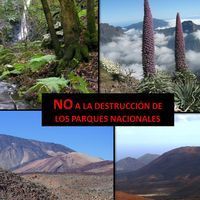
Uploads
Papers by José María Fernández-Palacios